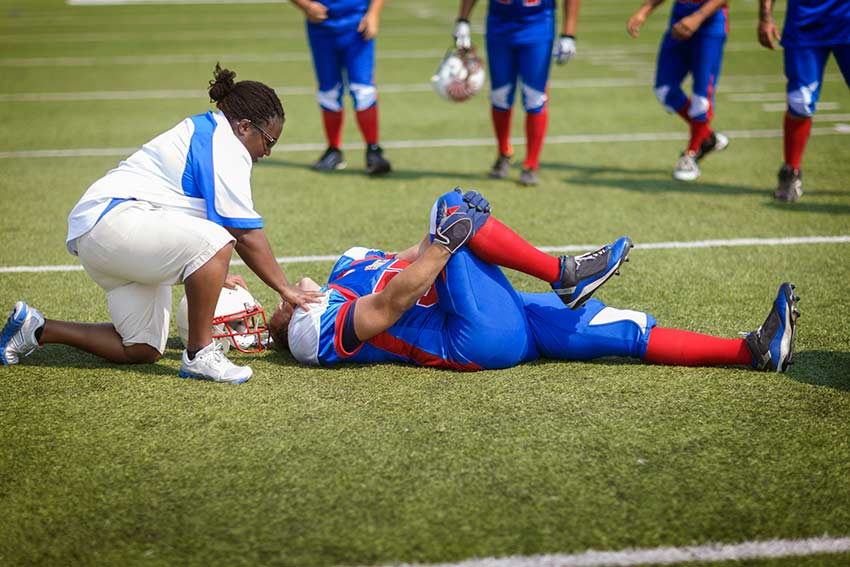Many adults and children in Ontario take part in recreational sporting activities on a daily basis. These may be contact sports, team sports, or even individual sports.
Regardless of the type of sport, however, the threat of sustaining an injury always looms – even for spectators. Injuries can range from something as simple as sprained wrist all the way to a devastating brain injury. Some sports injuries can result in lawsuits and liability coverage is often available for many sports injuries.
So, you’ve suffered an injury while playing sports. What’s your next step and what rights do you have?
Below, we take a look at everything you need to know about filing a sports injury claim – from high-risk sports to all aspects relating to civil liability and compensation for sports injuries and accident victims.
Keep reading to ensure that you protect your rights and receive the settlement you deserve.
Top Sports Activities That Cause Injuries
Some recreational sports are more likely to lead to serious injuries than others. For example, sports with higher levels of physical contact are far more likely to result in personal injury than sports that involve little to no contact.
While it’s possible for an accident or injury to occur from any type of sport or recreational activity, the activities mentioned below are high risk. This means the participants are prone to serious injuries.
So, to lower your chance of injuries arising, you may want to avoid some of the activities below or ensure that you are always wearing the correct protective equipment.
- Basketball: This is one of the more faced-paced and high-contact sports. So, it’s easy to serious injuries playing basketball.
- Football: In one year, as many as 460 000 people suffered a personal injury from football. Out of the 460 000, 10 000 people received treatment in hospital for serious injuries.
- Field and ice hockey: Hockey has definitely become a sport to play with caution. Not only does the hockey game itself have high physical contact levels, but the equipment used is also prone to causing injury. The hockey sticks, pucks flying across the rink, and the hard ice make it a recipe for disaster if players are not careful. More than 20 000 children in one year received treatment for hockey and ice hockey-related injuries. Many of the injuries sustained were concussions.
- Baseball and softball: While these sports are generally considered to be non-contact sports, more than half of the injuries result from two players colliding. Baseball and softball also involve dangerous apparatus like bats and hard balls.

Most Common Sports Injuries
Now that you are aware of some of the more dangerous sports, let’s take a look at the most common sports injuries one can expect to sustain when playing recreational sports. These include:
- Sprains and strains (usually of wrists and ankles)
- Knee injuries
- Torn and swollen muscles
- Head injuries
- Achilles tendon injuries
- Fractures
- Dislocations
What Are Your Legal Rights After Suffering A Sports Injury?
Injuries sustained from a sport or recreational activity may set you back financially, physically, or even emotionally. In other words, you may have medical bills to pay for treatments not covered by OHIP or have to take unpaid time off of work. Or, maybe you can never enjoy the sport you love again due to your injury.
When you suffer a sports injury, it’s crucial to know what your legal rights are. That way, you can receive the compensation you deserve for the injuries sustained.
So what are your legal rights? Who is liable? Any person on the sports field or at a sporting event who negligently causes you injury through contact may be liable for the injuries you sustained.
However, not every person who causes another injury during a sporting event is liable for that injury. Sports injuries differ from non-sporting injuries because of the concept of implied consent. Implied consent means that a person participating in sport consents to the risk of injury inherent to certain sports.
As a result, any injury caused by or likely to arise from the specific circumstances of the sport is not likely to lead to the liability of the party responsible. But, this only applies to inherent risks specific to the sport. In other words, the courts apply a flexible interpretation taking into account the rules and physical requirements of each sport.
If you suffer a sports injury and the accident occurred as a result of the following circumstances, the party responsible is likely cannot avoid liability:
- An intentional act by one player against another player.
- The recklessness of a player or players.
- Negligent coaching.

Liability For Sports Injuries
Civil liability for sports injuries is in a different category to ordinary personal injury claims like motor vehicle accidents. This is because civil liability does not arise in every case as a result of risks inherent to the sport or risks assumed by the participants.
Here is an outline of how tort law principles apply to sports injuries in Canada:
Tort Liability: Principles Of Negligence
One cannot apply the principles of tort liability to a sports injury case without some flexibility and by taking into account risks assumed and risks inherent to the sport. As such, a court must assess the defendant’s conduct in light of those factors when considering tort liability.
Further, the elements of tort law below are taken into account when it comes to determining whether the injuries give rise to a negligent claim and legal liability.
Negligence
This is essentially the area of tort law dealing with unintentional wrongs. In sporting activities, there are rules that govern how they should be played and what safety measures need to be in place.
Should an injury occur as a result of someone’s wrongdoing, then the wrongdoer may be held liable and would need to provide compensation.
Standard Of Care
The duty and standard of care is a type of legal obligation that sets out that a person must exercise a certain standard of reasonable care. This standard is determined and measured according to a “reasonable” person test. The test considers what a reasonable person (like an average man on the street) would do in the circumstances.
Essentially, this means that the law imposes a duty of care on individuals based on the presumption that they possess common sense. This individual should then identify inherent dangers and act in accordance with that identification by taking the necessary reasonable steps to prevent harm.
The application of the test is not strict and leaves room for the reasonable person to make mistakes and have a lapse in judgment. However, the reasonable person is cautious by nature and more alert to potential risks.
Further, when the courts apply the test, they do so by applying an objective standard of conduct. In other words, the reasonable person’s knowledge or lack thereof is not an excuse for their failure to act in accordance with the standard.
There are other aspects that influence the standard of care required by an individual in a situation. These aspects mentioned below relate to the inherent risk and the foreseeability of the harm:
- the severity of the risk (the seriousness of the potential harm).
- the frequency of the risk (the likelihood of the harm)
- the imminence of the risk
There are four factors that influence the standard of care:
- Written standards (statutes, regulations, equipment standards, procedural manuals, facility policies that are relevant to the sport)
- Unwritten standards (common sports practices)
- Case law (court decisions for similar incidents or cases)
- Common sense (an individual’s intuition and behaviours based on their knowledge and experience)
An example of an application of the standard of care in a sports context was in the case of Dyke v British Columbia. In this case, a scorekeeper in a softball game suffers a head injury after a foul ball hits him.
At the time, the flooding in the dugout led the scorekeeper to stand in an unprotected area. In this case, the court applied the above principles and found no breach in the standard of care as the facility provided safe alternatives for the scorekeeper to stand-in.
Causation
Causation is the final element required to prove a negligence claim. The negligence of the defendant must have caused the injury to the plaintiff. The court determines this element by applying the ‘but for’ test.
The court asks the question: But for the actions of the defendant, would the plaintiff suffer the harm? If the answer is ‘no,’ then the defendant will be liable for the harm.
If the answer is ‘yes,’ generally the defendant will be liable for the harm caused.
Another important aspect of causation is that the conduct of the defendant must be proximate to the harm. In other words, the defendant will not be liable if their actions were too remote from the harm caused. There must be a strong causal link in that the defendant’s negligence causes the harm.
Hussack v Chilliwack, another British Columbia case, dealt with the issue of causation. In this case, a schoolboy sustained a blow to the face with a field hockey stick while in his gym class. The blow to the head caused the student to suffer a concussion.
The concussion later leads to a more severe psychiatric injury known as a somatoform disorder. In this instance, the defence argued that the harm was not foreseeable.
The court held that it was, in fact, foreseeable that a student may sustain an injury from a hockey stick during gym class and, as a result, suffer a concussion and develop somatoform disorder as a consequence.
Damages
The usual remedy for a negligence claim is damages. A court awards damages to compensate the plaintiff for their actual and future financial losses.
The categories for which a plaintiff may receive a damages award are the following:
- Pain and suffering
- Medical and Rehabilitation costs
- Healthcare and other expenses
- Loss of earnings
- Future loss of earnings
In very rare cases, the court may award punitive damages. However, this is only in extreme cases of gross misconduct.
Damages are usually paid by the defendant, usually either a player or a sports organization, who should have taken reasonable care.
Further, the court awards damages for personal injury in circumstances of substantial loss and harm. As a result, scrapes, bruises, fright, or mental anguish will not always classify as substantial loss in the context of sports injuries.
Before awarding damages, courts will always consider the various circumstances and the risks inherent to sporting events.
Intentional Torts
When it comes to sporting events, there is a certain degree of assumed risk. For instance, the players assume the risks of the usual blows and collisions that are incidental to play. However, intentional torts are when wrongful acts are done on purpose. For example, if a player breaches the rules of the sport and injures someone else.
With the assumption of risk in sporting activities, the courts have attempted to define the limits and nature of implied consent. They have done so by distinguishing the normal and expected tackles and physical contact from the actions by players that are deliberately harmful and unnecessary to the game.
This is where intention plays an important role. Did the defendant intend to harm another player?
If the defendant could appreciate the nature of his actions and the potential to cause harm and continues to act in accordance with the appreciation, they may be held liable.
A well-known Canadian case known as Agar v Canning dealt with this point. In this case, an amateur hockey player proceeded to knock the plaintiff unconscious after he had hooked the defendant’s hockey stick.
In the circumstances, the court found that there was a clear intention on part of the defendant to inflict serious harm that was outside the ambit of the regular sports injuries.

Assumption Of Risk, Inherent Risk & Contributory Negligence
There are several other aspects the courts must consider when it comes to sporting injury claims and tort liability in general. These are assumption of risk, inherent risk, and contributory negligence.
Assumption Of Risk And Inherent Risk
These principles are the starting point of all sports injuries. Risk forms a part of all sports and, fortunately, the court does not expect players to avoid inflicting harm altogether.
For example, one knows that, when taking part in sporting activities, bruising, sprained limbs, and even concussions come with the territory of contact sports. In that way, players assume the risk. Similarly, rope burns from sports like rock climbing are also expected.
While the assumption of risk and inherent risk seem like the same thing, they are not. They operate differently when it comes to legal arguments.
For example, voluntary assumption of risk is a defence raised by the defendant once the plaintiff has proven negligence. The defendant must then prove that there has been a degree of consent to the injury by the plaintiff. This defence, however, rarely succeeds given the nature of the proof required.
The inherent risk in sports differs from the above defence in that it is likely to succeed in a case where no negligence is found. In other words, the plaintiff waived his legal claim by virtue of the fact that they participated in a sport with the inherent risk of injury.
Contributory Negligence
Contributory negligence often comes into play when determining damages. For example, a court may determine that the defendant was negligent but they are not liable to pay damages in the full amount as the plaintiff’s injuries were also a result of their own negligence.
This is the concept of contributory negligence and awards of damages are adjusted accordingly. Essentially, just as the law places a duty on every person to act with a certain standard of care, it also places the duty on a person to look out for their own wellbeing and safety.
Therefore, when a plaintiff’s own conduct contributes to their harm, they are said to be contributorily negligent.
Contributory negligence arises in three different situations where the plaintiff:
- Was a partial cause of the accident.
- Suffers injury after putting himself in a dangerous situation.
- Failed to take protective measures in a dangerous situation or dangerous sport.
In these instances, the court conducts an assessment and the plaintiff cannot benefit from his or her own careless conduct.
Waivers, Releases & Warnings
Often, a plaintiff seeks to hold sports associations vicariously liable for their sports injuries. Given the unpredictable nature of sporting events, however, the scope of liability is extremely wide. In this way, sporting associations may find themselves unnecessarily liable.
So, many associations have started insisting on exculpatory agreements that limit or completely waiver their liability for serious injury. Associations are not the only parties to benefit from these agreements – many individuals make use of them too.
These agreements are exculpatory and contain waiver, release, and indemnity clauses. All three fulfill the same purpose as they work to limit the scope of liability.
While sports associations and individuals still have the usual defences at their disposal such as the assumption of risk, inherent risk, and contributory negligence, once the defendant raises them, the burden of proof shifts from the plaintiff to the defendant. In such an instance, the defendant is tasked with proving its claim.
Whereas if the parties enter into an exculpatory agreement, the defendant’s liability is immediately limited and it is unlikely the injured person will have a claim in court. That’s because the effect of the waiver or release clause is that the operator or individual no longer has a duty of care toward the players or spectators.
As a result, if there is no longer a standard of care, there cannot be any obligation to compensate for any mishap. Essentially, there has been an effective waiver by the user.
Requirements For Waivers And Releases
It’s important that these clauses are well drafted. Should the agreement come under the scrutiny of the trial judge, he or she will apply a strict interpretation of the agreement and its contents.
The clauses of such an agreement should comply with the principles of legality and the following requirements:
- The agreement must be in writing
- It must be clear and unambiguous
- The agreement must clearly exclude negligence
- The parties’ attention must be directed to the limitation of the liability clause
Compliance with the above requirements is essential to avoid the dismissal of the agreement.
Player Liability
Assessing the liability of players requires a fair bit of interpretation. When a player suffers an injury as a result of another, the court must take into account the specific circumstances and inherent practices of the specific sports game.
The court must also consider the fact that fair play and appropriate body contact differ from sport to sport. As a result, courts should decide each case on its own merits.
For example, some sporting activities, like golf, allow participants the time to maneuver or plan their next move. In these instances, the court will expect a greater sense of care to prevent personal injury.
However, fast-paced sports, like hockey and football, allow players less time to think and make considered decisions. Therefore, the duty of care may not be as high.
Coach And Referee Liability
The common law of torts places a duty on coaches and referees to provide the correct instructions and ensure that the participants play according to the rules.
In other words, the law places a duty on coaches and referees to reduce the unnecessary danger that may inflict injury.
A coach must discharge his responsibilities in the following areas:
- Facilities and organization. The coach must select equipment and premises that are safe and suitable for the intended purpose.
- Instruction and supervision. This entails exercising reasonable care and control of the sporting activities to prevent injury.
- Medical care. There must be adequate medical kits on hand should any personal injury occur.
Facility Liability
Facility liability refers to the duty placed on-premises owners and/or occupiers to ensure that the property is fit for use. Many sporting injuries are a result of unkempt or hazardous infrastructure.
Because of this, the Occupiers’ Liability Act sets out obligations for premises occupiers to adhere to. However, liability does not always fall on the owner of the premises. It can, in certain instances, fall on those who control the premises.
For example, those who lease sporting facilities have an obligation to maintain the premises so that it is fit for their intended use. However, the Act only requires that the occupier take reasonable steps to ensure the safety of those entering the premises.
The reasonable steps required by the occupier include maintaining the premises, the activities on the premises as well as the activities of third parties. It is also essential that in maintaining the premises the occupier ensures adequate signage and lighting. But, the occupier’s liability does not extend to circumstances where even reasonable precautions could not prevent injury.
There are instances where owners/occupiers will not be liable for an injury sustained by a user of the property. These include if:
- Someone willingly assumes the risk on the property.
- Someone enters the property with the intention of committing a criminal offence.
- The person is a trespasser.
- The negligence of an independent contractor causes the injury.
Product Liability
This area of liability relates to the condition and safety of equipment used in sporting events. The general test for equipment is that it should be fit for use for the purpose for which it is intended.
Basically, a product may be considered defective if it does not work properly when used for an activity for which it was designed.
The test for product liability of safety equipment is a tricky one because the equipment itself may not be inherently dangerous. So, when applying the usual test to ascertain whether a product is inherently dangerous or not would not serve its purpose.
As a result, the courts take a contextual approach to interpretation. That being that safety equipment is inherently dangerous if it fails to provide reasonable protection when in normal use.
Spectator Injuries
There are several instances that may lead to the injury of a spectator. This may be due to an aspect of the sport, the condition of the premises, or the behavior of another spectator. Each instance must be carefully considered to ascertain whether liability arises.
For example, in a circumstance where a flying hockey puck hits a spectator, this may fall under risks inherent to the game. Or, the occupier of the premises may be liable where adequate safety equipment and structures were not put in place.
This area of tort liability, however, lacks case law precedents. As a result, each case must be considered in light of its unique facts and circumstances.

What To Do If You Were Injured While Playing Sports
It’s important that you first attend to your injury before considering whether you have any legal claim. First, inform your coach or the event facilitator of the injury and remove yourself from the field or the area where the injury occurred.
Seek the necessary medical help and take the time you need to rest. Once you recover, you may want to contact a personal injury lawyer to ascertain whether you have any claim for personal injury sustained.
It’s important at this stage that you gather any necessary evidence to assist your case. For example, any relevant CCTV footage, witness statements, and hospital bills. If the injury was a result of ill-maintained premises, it is necessary to obtain photographic evidence of this.
Compensation For Sports Injuries
If you suffer any type of sports injury, you can claim for the usual compensation applicable to tort law. These include:
- Pain and suffering.
- Actual and future loss of income.
- Medical expenses and future medical expenses.
The cost of a sports injury can be overwhelming. You may have medical bills as a result of treatments or ongoing rehabilitation or you had to take time off of work and ran out of paid sick leave. You may never be able to work again due to your injury and require compensation for future salaries.
Injuries of a serious nature may also lead to a decrease in your quality of life. As a result, you may want to claim pain and suffering.
So, if you have suffered a serious injury, you may have a claim for one or all of the above types of compensation. It’s important to consult a lawyer as soon as possible to ascertain what your rights are.
Why Hire A Personal Injury Lawyer?
Any kind of personal injury can end up being extremely overwhelming. Not only are you hurt and unable to continue with life as normal, but you may have many outstanding bills as a result.
There is no reason why a person should suffer and be worse off than he was before an injury that was not caused by his own negligence. That’s why it’s important to hire a personal injury lawyer to help you ascertain whether you have a claim and assist you with navigating that claim.
Even if you have an insurance policy, you may require assistance with lodging the claim. Or, in the unfortunate circumstance that the insurance company rejects your claim, you may need a personal injury lawyer to fight the terms of your insurance policy in a court of law.
A personal injury lawyer assists with so many aspects of your case including gathering evidence, advising, and compiling affidavits for the court file. Plus, they ensure that you abide by the strict court timelines.
So, if you have any sports injury that has impacted your life, be sure to reach out to a member of our team at Fosters Law.
Final Thoughts
It’s clear that there are many legal principles applicable to personal injury claims. From tort liability when it comes to players, the premises, and products to the available defences, it’s a difficult area of law for accident victims to navigate on their own.
So, if you find yourself suffering from sports-related injuries, be sure to approach a personal injury lawyer as soon as possible. With the right team, you can rest assured that your claim is in good hands and that you receive the compensation you deserve!




